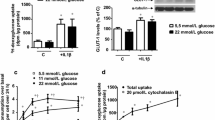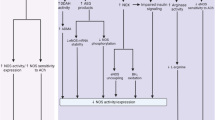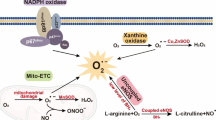Abstract
Hyperglycemia is the major causal factor in the development of endothelial dysfunction in patients with diabetes mellitus. Although the mechanisms underlying this phenomenon are likely to be multifactorial, recent in vivo and in vitro studies have indicated a crucial role of the diacylglycerol (DAG)-protein kinase C (PKC) pathway in mediating this phenomenon. PKC may have multiple adverse effects on vascular function, including the activation of superoxide-producing enzymes such as the nicotinamide adenine dinicleotide phosphate (NADPH) oxidase as well as increased expression of a dysfunctional, superoxide-producing, uncoupled endothelial nitric oxide synthase (NOS III).
PKC-mediated Superoxide production may inactivate nitric oxide (NO) derived from endothelial NOS III, but also may inhibit the activity and/or expression of the NO downstream target, the soluble guanylyl cyclase. Among the different isoforms of PKC, mainly the β-isoforms have been shown to be activated.
Recent studies with selective (isoform-specific) and non-selective PKC inhibitors show that they are able to beneficially influence glucose-induced endothelial dysfunction in experimental animal models as well as in patients, pointing to the therapeutic potential of these compounds in the prevention and treatment of vascular complications of diabetes.







Similar content being viewed by others
References
Ishii H, Koya D, King GL. Protein kinase C activation and its role in the development of vascular complications in diabetes mellitus. J Mol Med 1998; 76: 21–31
Brownlee M. Biochemistry and molecular cell biology of diabetic complications. Nature 2001; 414: 813–20
Schachinger V, Britten MB, Zeiher AM. Prognostic impact of coronary vasodilator dysfunction on adverse long-term outcome of coronary heart disease. Circulation 2000; 101: 1899–906
Suwaidi JA, Hamasaki S, Higano ST, et al. Long-term follow-up of patients with mild coronary artery disease and endothelial dysfunction. Circulation 2000; 101: 948–54
Heitzer T, Schlinzig T, Krohn K, et al. Endothelial dysfunction, oxidative stress, and risk of cardiovascular events in patients with coronary artery disease. Circulation 2001; 104: 2673–8
Ting HH, Timimi FK, Boles KS, et al. Vitamin C improves endothelium-dependent vasodilation in patients with non-insulin-dependent diabetes mellitus. J Clin Invest 1996; 97: 22–8
Tesfamariam B, Brown ML, Cohen RA. Elevated glucose impairs endothelium-dependent relaxation by activating protein kinase C. J Clin Invest 1991; 87: 1643–8
Pieper GM, Moore-Hilton G, Roza AM. Evaluation of the mechanism of endothelial dysfunction in the genetically-diabetic BB rat. Life Sci 1996; 58: PL147–52
Timimi FK, Ting HH, Haley EA, et al. Vitamin C improves endothelium-dependent vasodilation in patients with insulin-dependent diabetes mellitus. J Am Coll Cardiol 1998; 31: 552–7
Williams SB, Goldfine AB, Timimi FK, et al. Acute hyperglycemia attenuates endothelium-dependent vasodilation in humans in vivo. Circulation 1998; 97: 1695–701
Beckman JA, Goldfine AB, Gordon MB, et al. Ascorbate restores endothelium-dependent vasodilation impaired by acute hyperglycemia in humans. Circulation 2001; 103: 1618–23
Lund DD, Faraci FM, Miller Jr FJ, et al. Gene transfer of endothelial nitric oxide synthase improves relaxation of carotid arteries from diabetic rabbits. Circulation 2000; 101: 1027–33
Hink U, Li H, Mollnau H, et al. Mechanisms underlying endothelial dysfunction in diabetes mellitus. Circ Res 2001; 88: E14–22
Cosentino F, Hishikawa K, Katusic ZS, et al. High glucose increases nitric oxide synthase expression and Superoxide anion generation in human aortic endothelial cells. Circulation 1997; 96: 25–8
Vasquez-Vivar J, Kalyanaraman B, Martasek P, et al. Superoxide generation by endothelial nitric oxide synthase: the influence of cofactors. Proc Natl Acad Sci U S A 1998; 95: 9220–5
Xia Y, Tsai AL, Berka V, et al. Superoxide generation from endothelial nitric-oxide synthase: a Ca2+/calmodulin-dependent and tetrahydrobiopterin regulatory process. J Biol Chem 1998; 273: 25804–8
Kossenjans W, Eis A, Sahay R, et al. Role of peroxynitrite in altered fetal-placental vascular reactivity in diabetes or preeclampsia. Am J Physiol Heart Circ Physiol 2000; 278: H1311–9
Milstien S, Katusic Z. Oxidation of tetrahydrobiopterin by peroxynitrite: implications for vascular endothelial function. Biochem Biophys Res Commun 1999; 263: 681–4
Laursen JB, Somers M, Kurz S, et al. Endothelial regulation of vasomotion in apoE-deficient mice: implications for interactions between peroxynitrite and tetrahydrobiopterin. Circulation 2001; 103: 1282–8
Zou MH, Shi C, Cohen RA. Oxidation of the zinc-thiolate complex and uncoupling of endothelial nitric oxide synthase by peroxynitrite. J Clin Invest 2002; 109: 817–26
Boger RH, Sydow K, Borlak J, et al. LDL cholesterol upregulates synthesis of asymmetrical dimethylarginine in human endothelial cells: involvement of Sadenosylmethionine-dependent methyltransferases. Circ Res 2000; 87: 99–105
Masuda H, Goto M, Tamaoki S, et al. Accelerated intimai hyperplasia and increased endogenous inhibitors for NO synthesis in rabbits with alloxan-induced hyperglycaemia. Br J Pharmacol 1999; 126: 211–8
Cooke JP. Does ADMA cause endothelial dysfunction? Arterioscler Thromb Vasc Biol 2000; 20: 2032–7
Leiper J, Murray-Rust J, McDonald N, et al. S-nitrosylation of dimethylarginine dimethylaminohydrolase regulates enzyme activity: further interactions between nitric oxide synthase and dimethylarginine dimethylaminohydrolase. Proc Natl Acad Sci U S A 2002; 99: 13527–320
Lin KY, Ito A, Asagami T, et al. Impaired nitric oxide synthase pathway in diabetes mellitus: role of asymmetric dimethylarginine and dimethylarginine dimethylaminohydrolase. Circulation 2002; 106: 987–92
Pieper GM, Siebeneich W, Dondlinger LA. Short-term oral administration of Larginine reverses defective endothelium-dependent relaxation and cGMP generation in diabetes. Eur J Pharmacol 1996; 317: 317–20
Pritchard Jr KA, Groszek L, Smalley DM, et al. Native low-density lipoprotein increases endothelial cell nitric oxide synthase generation of Superoxide anion. Circ Res 1995; 77: 510–8
Guzik TJ, Mussa S, Gastaldi D, et al. Mechanisms of increased vascular super-oxide production in human diabetes mellitus: role of NAD(P)H oxidase and endothelial nitric oxide synthase. Circulation 2002; 105: 1656–62
Oelze M, Mollnau H, Hoffmann N, et al. Vasodilator-stimulated phosphoprotein serine 239 phosphorylation as a sensitive monitor of defective nitric oxide/ cGMP signaling and endothelial dysfunction. Circ Res 2000; 87: 999–1005
Stroes E, Kastelein J, Cosentino F, et al. Tetrahydrobiopterin restores endothelial function in hypercholesterolemia. J Clin Invest 1997; 99: 41–6
Heitzer T, Brockhoff C, Mayer B, et al. Tetrahydrobiopterin improves endothelium-dependent vasodilation in chronic smokers: evidence for a dysfunctional nitric oxide synthase. Circ Res 2000; 86: E36–41
Heitzer T, Krohn K, Albers S, et al. Tetrahydrobiopterin improves endothelium-dependent vasodilation by increasing nitric oxide activity in patients with type II diabetes mellitus. Diabetologia 2000; 43: 1435–8
Park JY, Ha SW, King GL. The role of protein kinase C activation in the pathogenesis of diabetic vascular complications. Perit Dial Int 1999; 19: S222–7
Inoguchi T, Battan R, Handler E, et al. Preferential elevation of protein kinase C isoform beta II and diacylglycerol levels in the aorta and heart of diabetic rats: differential reversibility to glycemic control by islet cell transplantation. Proc Natl Acad Sci U S A 1992; 89: 11059–63
Ishii H, Jirousek MR, Koya D, et al. Amelioration of vascular dysfunctions in diabetic rats by an oral PKC beta inhibitor. Science 1996; 272: 728–31
Tesfamariam B, Cohen RA. Role of Superoxide anion and endothelium in vasoconstrictor action of prostaglandin endoperoxide. Am J Physiol 1992; 262 (6 Pt 2): H1915–9
Hirata K, Kuroda R, Sakoda T, et al. Inhibition of endothelial nitric oxide synthase activity by protein kinase C. Hypertension 1995; 25: 180–5
Lassegue B, Sorescu D, Szocs K, et al. Novel gp91(phox) homologues in vascular smooth muscle cells: noxl mediates angiotensin II-induced Superoxide formation and redox-sensitive signaling pathways. Circ Res 2001; 88: 888–94
Inoguchi T, Li P, Umeda F, et al. High glucose level and free fatty acid stimulate reactive oxygen species production through protein kinase C: dependent activation of NAD(P)H oxidase in cultured vascular cells. Diabetes 2000; 49: 1939–45
Griendling KK, Sorescu D, Ushio-Fukai M. NAD(P)H oxidase: role in cardiovascular biology and disease. Circ Res 2000; 86: 494–501
Jones SA, O’Donnell VB, Wood JD, et al. Expression of phagocyte NADPH oxidase components in human endothelial cells. Am J Physiol 1996; 271: H1626–34
Wang HD, Pagano J, Du Y, et al. Superoxide anion from the adventitia of the rat thoracic aorta inactivates nitric oxide. Circ Res 1998; 82: 810–8
Bastian NR, Hibbs Jr JB. Assembly and regulation of NADPH oxidase and nitric oxide synthase. Curr Opin Immunol 1994; 6: 131–9
Gorlach A, Brandes RP, Nguyen K, et al. A gp91phox containing NADPH oxidase selectively expressed in endothelial cells is a major source of oxygen radical generation in the arterial wall. Circ Res 2000; 87: 26–32
Dekker LV, Leitges M, Altschuler G, et al. Protein kinase C-beta contributes to NADPH oxidase activation in neutrophils. Biochem J 2000; 347: 285–9
Nishikawa T, Edelstein D, Du XL, et al. Normalizing mitochondrial Superoxide production blocks three pathways of hyperglycaemic damage. Nature 2000; 404: 787–90
Li H, Oehrlein SA, Wallerath T, et al. Activation of protein kinase C alpha and/or epsilon enhances transcription of the human endothelial nitric oxide synthase gene. Mol Pharmacol 1998; 53: 630–7
Drummond GR, Cai H, Davis ME, et al. Transcriptional and posttranscriptional regulation of endothelial nitric oxide synthase expression by hydrogen peroxide. Circ Res 2000; 86: 347–54
Mulsch A, Bauersachs J, Schafer A, et al. Effect of YC-1, an NO-independent, superoxide-sensitive stimulator of soluble guanylyl cyclase, on smooth muscle responsiveness to nitrovasodilators. Br J Pharmacol 1997; 120: 681–9
Ruetten H, Zabel U, Linz W, et al. Downregulation of soluble guanylyl cyclase in young and aging spontaneously hypertensive rats. Circ Res 1999; 85: 534–41
Skyrme-Jones RA, O’Brien RC, Berry KL, et al. Vitamin E supplementation improves endothelial function in type I diabetes mellitus: a randomized, placebo-controlled study. J Am Coll Cardiol 2000; 36: 94–102
Pinkney JH, Downs L, Hopton M, et al. Endothelial dysfunction in Type 1 diabetes mellitus: relationship with LDL oxidation and the effects of vitamin E. Diabet Med 1999; 16: 993–9
O’Driscoll G, Green D, Rankin J, et al. Improvement in endothelial function by angiotensin converting enzyme inhibition in insulin-dependent diabetes mellitus. J Clin Invest 1997; 100: 678–84
O’Driscoll G, Green D, Maiorana A, et al. Improvement in endothelial function by angiotensin-converting enzyme inhibition in non-insulin-dependent diabetes mellitus. J Am Coll Cardiol 1999; 33: 1506–11
Cheetham C, Collis J, O’Driscoll G, et al. Losartan, an angiotensin type 1 receptor antagonist, improves endothelial function in non-insulin-dependent diabetes. J Am Coll Cardiol 2000; 36: 1461–6
Cheetham C, O’Driscoll G, Stanton K, et al. Losartan, an angiotensin type I receptor antagonist, improves conduit vessel endothelial function in type II diabetes. Clin Sci (Colch) 2001; 100: 13–7
Mullen MJ, Wright D, Donald AE, et al. Atorvastatin but not L-arginine improves endothelial function in type I diabetes mellitus: a double-blind study. J Am Coll Cardiol 2000; 36: 410–6
Tsunekawa T, Hayashi T, Kano H, et al. Cerivastatin, a hydroxymethylglutaryl coenzyme a reductase inhibitor, improves endothelial function in elderly diabetic patients within 3 days. Circulation 2001; 104: 376–9
Beckman JA, Goldfine AB, Gordon MB, et al. Inhibition of protein kinase Cbeta prevents impaired endothelium-dependent vasodilation caused by hyperglycemia in humans. Circ Res 2002; 90: 107–11
Yusuf S, Sleight P, Pogue J, et al. Effects of an angiotensin-converting-enzyme inhibitor, ramipril, on cardiovascular events in high-risk patients: the Heart Outcomes Prevention Evaluation Study Investigators. N Engl J Med 2000; 342: 145–53
Munzel T, Keaney Jr JF. Are ACE inhibitors a magic bullet against oxidative stress? Circulation 2001; 104: 1571–4
Wagner AH, Kohler T, Ruckschloss U, et al. Improvement of nitric oxide-dependent vasodilatation by HMG-CoA reductase inhibitors through attenuation of endothelial Superoxide anion formation. Arterioscler Thromb Vasc Biol 2000; 20: 61–9
Laufs U, La Fata V, Plutzky J, et al. Upregulation of endothelial nitric oxide synthase by HMG CoA reductase inhibitors. Circulation 1998; 97: 1129–35
Goldberg RB, Mellies MJ, Sacks FM, et al. Cardiovascular events and their reduction with pravastatin in diabetic and glucose-intolerant myocardial infarction survivors with average cholesterol levels: subgroup analyses in the cholesterol and recurrent events (CARE) trial: the CARE Investigators. Circulation 1998 Dec 8; 98(23): 2513–9
Prevention of cardiovascular events and death with pravastatin in patients with coronary heart disease and a broad range of initial cholesterol levels: the Long-Term Intervention with Pravastatin in Ischaemic Disease (LIPID) Study Group. N Engl J Med 1998 Nov 5; 339(19): 1349–57
Title LM, Cummings PM, Giddens K, et al. Oral glucose loading acutely attenuates endothelium-dependent vasodilation in healthy adults without diabetes: an effect prevented by vitamins C and E. J Am Coll Cardiol 2000; 36: 2185–91
Yusuf S, Dagenais G, Pogue J, et al. Vitamin E supplementation and cardiovascular events in high-risk patients: the Heart Outcomes Prevention Evaluation Study Investigators. N Engl J Med 2000; 342: 154–60
Keaney Jr JF, Gaziano JM, Xu A, et al. Low-dose alpha-tocopherol improves and high-dose alpha-tocopherol worsens endothelial vasodilator function in cholesterol-fed rabbits. J Clin Invest 1994; 93: 844–51
Palmer AM, Thomas CR, Gopaul N, et al. Dietary antioxidant supplementation reduces lipid peroxidation but impairs vascular function in small mesenteric arteries of the streptozotocin-diabetic rat. Diabetologia 1998; 41: 148–56
Author information
Authors and Affiliations
Corresponding author
Rights and permissions
About this article
Cite this article
Hink, U., Tsilimingas, N., Wendt, M. et al. Mechanisms Underlying Endothelial Dysfunction in Diabetes Mellitus. Mol Diag Ther 2, 293–304 (2003). https://doi.org/10.2165/00024677-200302050-00001
Published:
Issue Date:
DOI: https://doi.org/10.2165/00024677-200302050-00001




